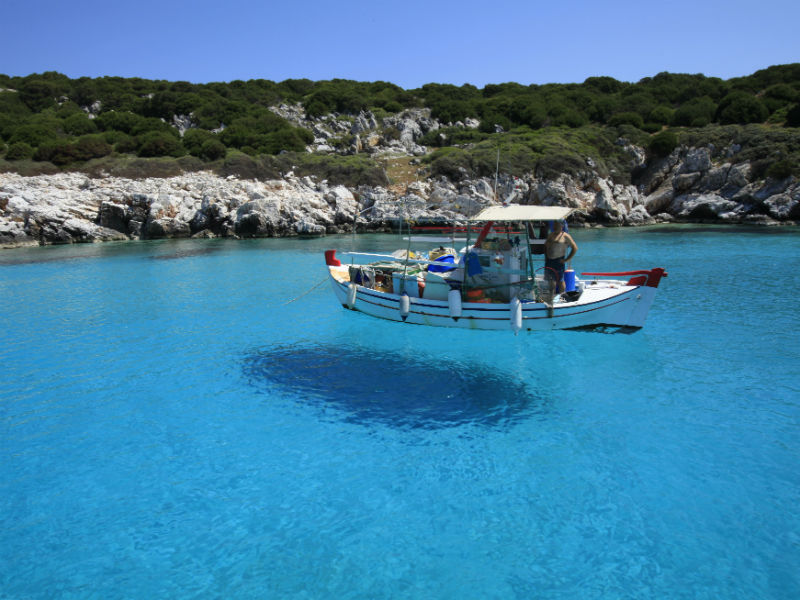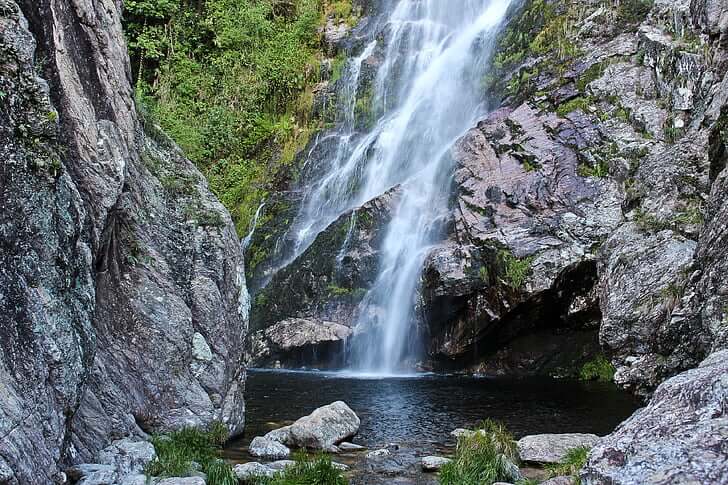The Avandes
When the Greek armies besieged and conquered Troy, among them, were the citizens of Euboea called Avandes. Homer ( book Iliad, rhapsody B) narrated how these fearless warriors, under the commands of Heleniforas, the king of Halkida, took part in the Troyan War with 40 ships. Their last king, called Amfidamas, was killed in a naval battle against the Eretrians in 9th century BC. It was the end of the period of Reign and the beginning of Oligarchy. The conflict between Halkida and Eretria, that lasted for two centuries(720-660 BC), because of the fertile area of the Lelandio Pedio, had serious consequences to both towns, although Halkida won.
The Colonies
Both Halkidians and Eretrians used to be among the first Greeks who traveled the west seas for trade. In the 8th century, both towns seemed to collaborate in financial and political affairs. At the time, Euboea used to stand in the first rank of colonists, since Halkida, Eretria, and Kymi founded a significant number of colonies in Italy, Sicily, in the Eastern Mediterranean and Halkidiki. The best known among them were Naxos, Katani, Messini, Kallipolis, Kymi, Region, Posedonion, Adarados on the coast of Palestine, Neapolis in North Africa, Olinthos in Halkidiki. Kymi taught Italians the Halkidian Alphabet which was the base for the Latin Alphabet. The flourishing of trade and navigation led to the change of the political state; from aristocracy to “ timocracy”, since the government was in the hands of merchants, ship-owners, manufacturers, who soon lost people’s trust and gave their place to Tyranny, with Tinodas as the governor. During this period pottery throve in Halkida.
Athenian Dominance and Struggle
In 506 BC Halkida becomes a member of the Euboean Federation and was sided with the Peloponnesians, who under the commands of the Spartan king Keomenis, moved against Athens. The Halkidians, at first, conquered several places on the north of Athens, but conflicts in the alliance of the Peloponnesians led the expedition to failure and left Halkidians exposed to the wrath of Athens, that defeated and mocked them. Athens conquered and divided Lelandio Pedio to 4000 Athenians. These misfortunes drove to the final end of the evaluation of Halkida. Eretrians paid less their involvement on the side of the Viotians during the war. Athens imposed Democracy to both towns.
The wars against the Persians
During these wars, Euboea comes forward with Eretria. The fact that Eretria assisted Militos by offering ships, during the Ionian Revolution, rose the vindictive anger of the Persian king Dates and Artafernis, who in 490 BC literally leveled the town and slaughtered its citizens. This expedition of Persians ended with their defeat in the battle of Marathonas. During the second expedition against Greece, under the commands of Xerxis in 480 BC, after the sea-fight in Artemissio, the retreat of the Greek ships in Salamina and the heroic ending of Leonidas in the battle of Thermopiles, Euboea was left unprotected in the wrath of the conquerors, who pillaged and burnt Halkida , this time. Halkidians took part in 479 BC in the last victorious battle against the Persian army in Plateaus.
The Peloponnesian war
In 432 BC the Euboean colonies in Halkidiki rebelled from the Athenian Alliance and their citizens under the Macedonian king Perdikas were gathered in Olinthos. These rebels, against whom Athens marched, were assisted by the town of Corinth. This caused the pretense to drive to war the democratic town of Athens against the Peloponnesian town of Sparta, which was ruled with Oligarchy. At first, Halkidians were on the side of the Athenians, with a lot of desertions though. In the end, they were sided with the Spartans. Losing the war, Athens also lost Euboea which then met the worst allies than the former ones.
Macedonian Sovereignty
The dream of the Macedonian king Philip the 2nd to unite all the Greek towns including Halkida and the rest towns of Euboea. Philip created polar supports in Euboea, which used to be on the side of Athens, thus some Euboean leaders decided to be in favor of the new, coming from the North, powerful king. Having as a leader the Halkidian Kallias, Euboea followed an extravagant, changeable policy, being at first in favor of Macedonians and then on the side of Athens, a strategy that drove them to defeat in the battle of Heronia in 338 BC. Halkida became the naval base of Macedonians and was fortified. Since then Euboea’s relations with Macedonia remained remarkably good. Alexander’s teacher, philosopher Aristotle, because of this good relation with Macedonians and because his mother came from Stagira, which was Halkida’s colony, decided to abandon Athens, because of the widely spread among the citizens of Athens anti – Macedonian attitude and settled in Halkida, where he died in 322 BC, working on the strange phenomenon of the tide of Evripus.
Bound by Roman Influence
During the Second Macedonian War (205-171 BC) among other events, the occupation of Euboea from the Romans under the command of General Gaios Klaudios Kentonas and the disaster of Oreos in North Euboea, Halkida and Eretria were also included. These of high historical importance towns were literally leveled and almost none citizen remained alive. This horrifying cruelty caused the reaction of the Senate, that sent to Euboea in 194 BC General Flaminius. He ruled Euboea adopting a flexible, diplomatic manner since he retracted the Roman Guards and declared Euboea’s liberation, placing governors who were in favor of the Romans though. When Flaminius left, new anti-Roman movements took place in Euboea. In 146 BC Euboea was destroyed once again by the Romans, because of their support offered to the Archaic Federation against Rome. Then was the beginning of the era of the absolute Roman domination in Euboea. The attempt of the king of Pondos, Mithridates, to conquer Halkida fails, because of the most powerful General Syllas.
The Byzantine Era
During this era, generally significant works, that led to the evaluation of the island took place. Justinian (527-565 AD) thought that Halkida was of great strategic importance and moved towards the support of its fortifying and constructed a trail-net bridge over the channel of Euripus. During this period the temple of Santa(Agia) Paraskevi was built.
The Era of Domination by the Venetians
The Franks of the 4th Crusade occupied in 1204 AD Constantinople and the following year Halkida; the citizens though didn’t react. Since 1209 AD Halkida was under the occupation and control of the Venetians, who extended their domination to the whole “Negroponte”, as they used to call Euboea. In the 13th century, the island was ruled by a Venetian governor called “vailus”, who was settled in Halkida. His house used to be opposite the temple of Santa Paraskevi and remains there till nowadays. The town used to be the headquarters of the Latin Bishop(1260), who stayed at the spot where now the square of the Turkish temple stands. At the time remarkable castles were built on the island, such as Castelo Rosso in Karystos, the Castle of the Leaves over the Lelandio Pedio, the Castle of Klesoura in Derveni, the castles in Stira, Avlonary, Oreous, Fylagra, etc. Under the rather “loose” domination of Venice, Euboea flourished both in terms of trade and culture. The attempt of the Byzantines to occupy the island again, during the reign of Michael Paleologos, took place under the commands of the Venetian knight Lecarious, who came from Karystos. After a number of victories, he finally failed to occupy Halkida and settled at the Castle of the Leaves until his unidentified death. Gradually the Franks recaptured the places they had lost.
Τhe Era during the Turkish Occupation
Seventeen years after the capture of Constantinople, Moameth the Conqueror reached with his numerous army Halkida and besieged the town. on 20th June 1470 started a merciless bombing of the town and on the morning of 12th July the resistance of the defenders under the governor Erizus Paul retreated and he found dreadful death as most of the citizens of Halkida over 8 years old. The vindictive wrath of the Sultan was unspeakable. The assistance that the Halkidians had been waiting from the fleet of the Venetian Admiral Canale, that had cast anchor in the port of Politika, never came. The town was abandoned in its horrible fate and suffered the worst cruelty in its history. From Halkida the Turkish occupation was spread throughout the island of Euboea and life gradually gained its daily routine. In 1688 there was a serious, yet unsuccessful attempt of the revolution took place in 1770 with “Orlofica” and later on in 1789 with the liberating movements of Lambros Katsonis in Karystos that led to failure with the sea-fight in Andros.
In the year 1821(During the Greek Revolution against the Turkish Occupation)
In May 1821 the revolution started on the northern part of Euboea, in Istiea. In the first fight, the Greek won. They moved to the South and united with the local rebels having as a goal the liberation of Halkida. Ulysses Adroutsos named as a leader of the Euboean army Aggelis Govios, who came from Limni and soon achieved to organize a brave and in good fighting condition army, that won the Turks, who were under the commands of Omer Bey, in a place called “ Vryssakia” Politikon in July 1821. A great number of heroic figures distinguished themselves during the Euboean Revolution. The most famous ones were Kriezotis, Kotsos, Euboeas Neofitos, Balaley brothers. Conflicts among them had, as a result, the gradual decline of the revolution having as a final blow the defeat in Kakia Scala of Aliveri and the failure of Kriezotis to liberate Karystos and similarly Kodokostas Aliveri in 1824. Euboea remained under the Turkish domination until 25th March 1833, when with the Convention of London it was surrendered to Greece.
Until Recent Time
After the liberation from the Turks Euboea’s history” keeps pace with” the Modern Greek History. Any kind of political conflicts has tragic consequences in Euboea, too. Soon after the island’s liberation from the Turks, notorious brigands found shelter on the Euboean mountains. In 1922 a great number of immigrants from the Minor East Coast came to Euboea and built their new homes. During the 2nd World, War Halkidians suffered a lot from the German occupation, having as their only support the Orthodox Bishop of Halkida Gregory. Nowadays, the people of Euboea are proud of the well-known personalities who came from their island as the musician Nick Skalkotas, the writer John Skaribas, the doctor Nick Papanikolaou and the painter Dimitris Mytaras.

